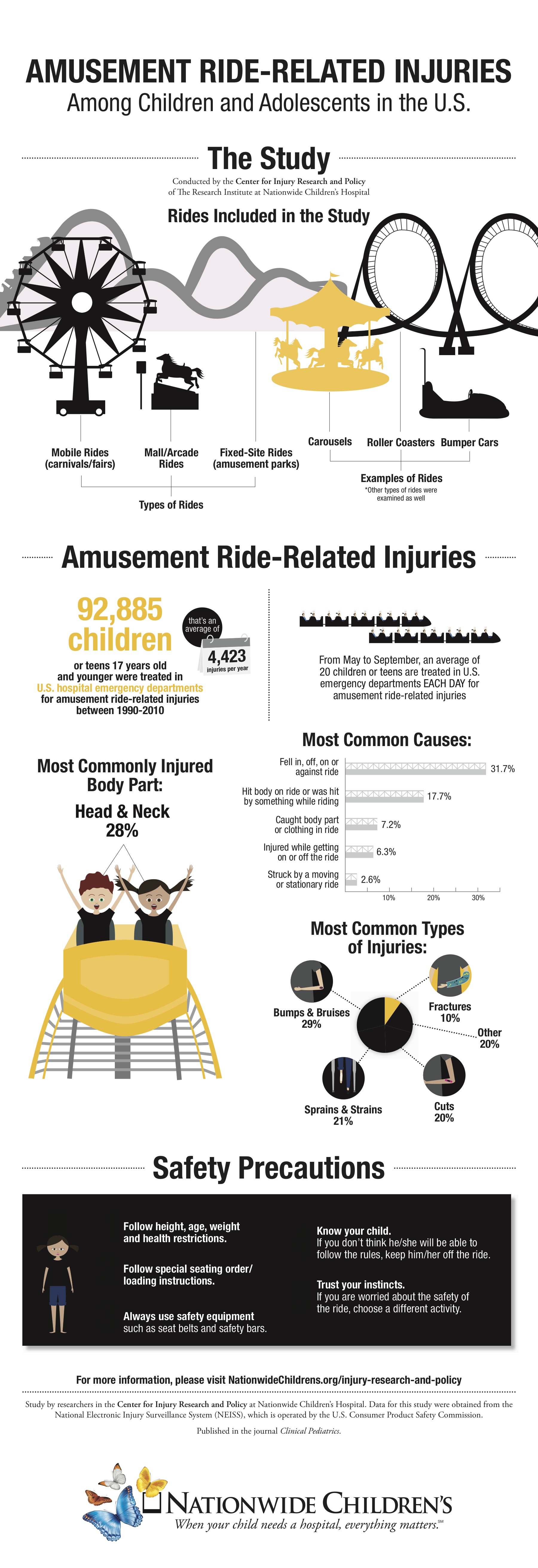Thrills and Spills: Amusement Rides' Surprising Child Toll (Op-Ed)


Tracy Mehan, manager of translational research at the Center for Injury Research and Policy, Nationwide Children’s Hospital, contributed this article to LiveScience’s Expert Voices: Op-Ed & Insights.
This summer, millions of people will head to the nation’s amusement parks. Many might assume that the bigger and faster rides account for the most amusement ride-related injuries to children, but that’s not always the case.
My colleagues and I at the Center for Injury Research and Policy, Nationwide Children’s Hospital, did the first study that looks in detail at children who are injured on amusement rides, which includes rides at amusement parks (fixed-site rides), rides at fairs and festivals (mobile rides) and rides found at local malls, stores, restaurants or arcades (mall rides).
From 1990 to 2010, 92,885 children under age 18 were treated in U.S. emergency departments for amusement ride-related injuries for an average of 4,423 injuries each year. More than 70 percent of the injuries happened during the warm summer months of May through September — averaging more than 20 injuries a day during those months. [Killer Thrills: How Safe Are Amusement Parks?]
We found that most children were injured in the head and neck region, followed by the arms, face and legs. Soft-tissue injuries like bruises were the most common type of injury, followed by strains and sprains, cuts and broken bones.
Most of the injuries do not mean a stay at the hospital for the children involved — however, during the summer months, on average there is an amusement ride-related injury that is serious enough to require hospitalization once every three days.
Children were most likely to be injured because they fell or hit a part of their body on a ride, or were hit by something while riding. Nearly one-third of injuries occurred on a fixed-site ride, followed by mobile rides and "mall" rides.
Get the world’s most fascinating discoveries delivered straight to your inbox.
Although the U.S. Consumer Product Safety Commission has jurisdiction over mobile rides, regulation of fixed-site rides is currently left to state or local governments — leading to a fragmented system. We believe that a coordinated national system would help us prevent amusement ride-related injuries through better injury surveillance and more consistent enforcement of standards.
The study also found that injuries from "mall rides" differed from other types of rides. Children injured on a “mall ride” were more likely to hurt their head/neck or face, or get a concussion. Almost three-fourths of the “mall ride” injuries occurred when a child fell in, on, off or against the ride. These types of rides may be placed over hard surfaces and may not have child restraints, which contributes to the injury risk.
Injuries from smaller amusement rides located in malls, stores, restaurants and arcades are typically given less attention by legal and public health professionals than injuries from larger amusement park rides, yet our study showed that in the U.S. a child is treated in an emergency department, on average, every day for an injury from an amusement ride located in a mall, store, restaurant or arcade.
We need to raise awareness of this issue and determine the best way to prevent injuries from these types of rides.
Some tips for keeping your child safe on amusement rides include:
- Always follow all posted height, age, weight and health restrictions.
- Make sure to follow any special seating order and/or loading instructions.
- Always use safety equipment such as seat belts and safety bars.
- Keep your hands and feet inside the ride at all times.
- Know your child. If you don’t think he/she will be able to follow the rules, keep him/her off the ride.
- Trust your instincts. If you are worried about the safety of the ride, choose a different activity.
- Avoid “mall rides” if they are over a hard, unpadded surface or if they don’t have a child restraint such as a seat belt.
Author's note: This is the first study to describe national rates of pediatric injury involving amusement rides treated in U.S. emergency departments. Data for this study were obtained from the National Electronic Injury Surveillance System (NEISS), which is operated by the U.S. Consumer Product Safety Commission.
The views expressed are those of the author and do not necessarily reflect the views of the publisher. This article was originally published on LiveScience.com.



